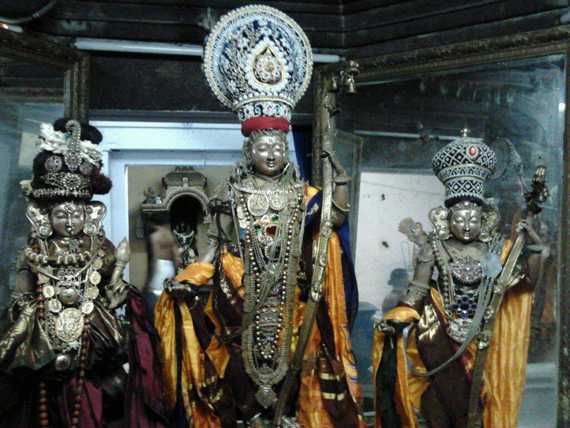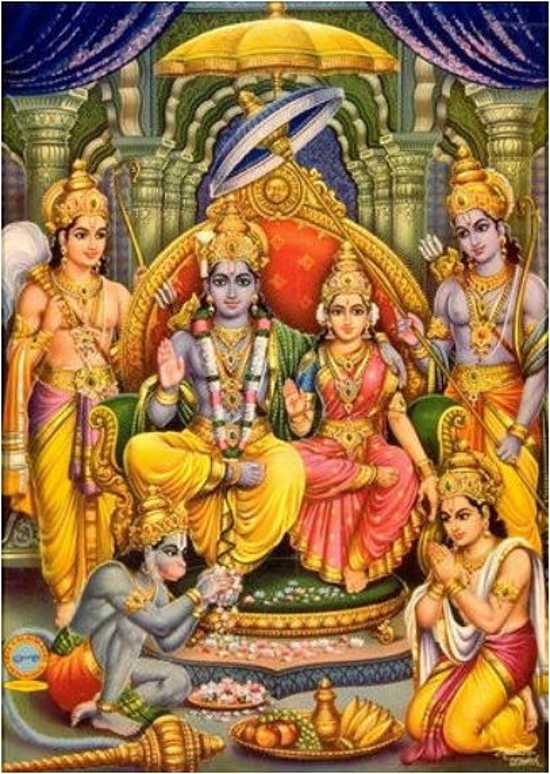Article by Sri Sadagopan Iyengar Swami, Coimbatore
Countless books have been authored since creation, by countless worthies, dealing with practically every subject under the Sun. And to each of these books, its author, with parental pride, has given a name, which he or she thought suited it best. To each author, his creation, however insignificant it may appear to others, is indeed a magnum opus deserving of appreciation and acclaim. However, none has considered his or her book fit enough to be called “The Beautiful Book”. You must have read any number of books—have you come across one titled simply “The Beautiful Book” There is indeed one, for which the venerated author couldn’t think of any other name than the beautiful one mentioned above. Looked at from any angle, it appeared so fine and striking to him, that try as he might, he couldn’t come up with any other title, which suited the work to a “T”. Irrespective of what impressive names we might give our children, it is their character, conduct and comportment that ultimately give their names popular acceptance—if a dunce carries the name “VivEkAnandan”, in course of time, people would coin for him nickname which indicates his true colours, rather than call him by the given name. So too is the case of any name. That the author-given name of “The Beautiful Book” (for the work we talked about) has gained popular acceptance too, is indicative of the book’s enchanting and enticing contents.
The “Sundara KANdam” of Srimad Ramayanam carries an extremely apt name. Sri Valmiki himself was so impressed by its contents that he could think of no other name for it than the aforesaid. While other KANdAs of the epic have been named after the places where the events are enacted (AyOdhyA KANdam, AraNya KAndam, KishkindhA KANdam) or after the nature of happenings (BAla KANdam, Yuddha KANdam), this particular portion of the saga is simply named “Sundara KANdam”.
Does this mean that the other parts of the epic are not beautiful? Why should this particular KANdam be celebrated as the Sundara KANdam?
Why does this specific KANdam command much greater popularity among Rama bhaktAs than the other parts of the great saga? And if the recital of this particular KANdam is traditionally held to be capable of fulfilling all of one’s wishes, what could be the special content that it has, which puts it head and shoulders above the other portions of the epic?
While there are several reasons for this part of Valmiki’s magnum opus getting this “beautiful” sobriquet, the principal ones are the following:-
1. This part of the Epic really contains enthralling descriptions of several beautiful objects, places and people. Be it the portrayal of Lanka, of the exalted Pushpaka vimAnam, the AshOka vanikA, the Madhu vanam or of natural phenomena like the Moonrise, Sri Valmiki excels himself in painting gripping pen-portraits, with elaborate and enthralling accounts of flora, fauna, the majesty of nature at its best, the lure and lustre of Lanka etc. Being a past master at apt similes, the Maharshi’s portrayals often appear to be more glorious than the objects of their adoration, if such a thing were possible. Here is a simple sample from the 5th Sarga of this KANda, devoted mainly to the description of the rising Moon over the city of Lanka. Observe the lilting metre, the thrilling portrayal, the extremely apt similes and the cumulative effect of unparalleled prettiness and picturesqueness the entire scenario presents—
“Tata: sa madhyam gatam amsumantam
JyOtsnA vitAnam mahat udvamantam
Dadarsa dheemAn divi BhAnumantam
GoshttE vrisham mattham iva bhramantam”
The huge Silver Orb in the sky, surrounded by a halo of pleasing luminance, occupying the centre spot among an admiring audience of countless stars exhibiting their adulation through constant twinkling, looked like a virile Bull pacing majestically among admiring cows, says Sri Valmiki.
Here is a slew of more similes from the facile pen of the Adikavi, comparing the resplendent Moon glowing in the bewitching night sky, to a graceful Swan in a silver cage, to a majestic lion inhabiting a broad cave in the Mandara mountain and to a victorious centurion ensconced on an imposing elephant—
“HamsO yathA rAjata panjarasttha: simhO yathA Mandara kandarasttha:
VeerO yathA garvita kunjarasttha: ChandrOpi babhrAja tathA ambarasttha:”
What beautiful metre, what incomparable similes, what inimitable portrayals! Is it any wonder that this forms part of the “Sundara KANdam”? Though it is extremely tempting to quote one lilting verse after another, which competes for our attention and adulation, I leave readers to feast themselves on these gems at their leisure.
However, is it merely due to the gloriously graphic descriptions that this KANdam is known as the Sundara Kandam, for, equally facile portrayals are to be found in other parts of the epic too, especially the accounts of Spring, Autumn and the Monsoon seasons and innumerable other pen-portraits, of which only Sri Valmiki is capable.
2. This Kandam is almost exclusively about the exploits of an extremely beautiful person (“Sundara:”)—none other than Sri Hanuman. It is beyond dispute that Sri AnjanEya is extremely handsome, virile and strikingly attractive. “KAnchanAdri kamanIya vigraham” says the PArAyaNa slOka, telling us that the VAnara veera possessed glorious good looks and shone like a veritable Golden Mountain, with his gigantic physique and commanding personality. When we go through Sundara KANdam, we find it to be one long and continuous saga of Sri Hanuman’s adventures and exploits, in the service of His Lord and Master, Sri Rama. The KANda begins with a vivid account of Hanuman’s launch into the long, difficult and hurdle-filled flight across the ocean to Lanka, a feat none else would even contemplate, leave alone attempt. What follow are enthralling accounts of the MahAkapi’s rigorous search for Sri Sita, his timely arrival on the scene to prevent Sri Mythily from taking Her life and to extend assurances of imminent rescue by Sri Raghava, his vanquishing the minions, ministers and sons of Ravana in a patently unequal battle, his challenge to the demoniac king and departure to Kishkindha to convey the good news to the Prince of Ayodhya, leaving Lanka engulfed in flames.
Thus, from commencement to conclusion, this KANda is verily monopolised by the “Sundara”, Sri Hanuman, who is on centre stage, throughout.
3. What could be more beautiful than tales of the Lord and accounts of His handsomeness, valour, majesty, generosity and boundless compassion? Anything incorporating such a narrative definitely deserves the name “Beautiful Book”. The Sundara Kanda contains several such descriptions of Sri Raghava’s glorious physical and psychological traits. The 31st Sarga contains a detailed account of the IkshvAku Vamsam and Sri Rama’s glorious guNAs, the 35th a mouth-watering description of His matchless physical beauty, the 51st again a narrative of the Prince’s valour, prowess and compassion. With the recurring theme of Bhagavat divya mangaLa vigaraha varNanam and Bhagavat guNa anubhavam, there is little wonder that this portion of the epic is known as the Sundara Kanda.
4. Whether it be in physique or in character, could anyone hope to equal Sri Mythily, the epitome of womanly virtue and seemliness?
She is thus a real “Sundari”, beautiful beyond imagination and looking as if She was put together by the Divine Architect, using up all the stock of beauty on hand—“DEva mAyEva nirmitA”. It was a divine beauty, such as only the Divine Consort could possess. If we come to think of it, this Kandam devotes a major portion of its content to this “Sundari”, Her travails amidst the rAkshasIs of AshOka vanikA, Her encounters with the dastardly Ravana, Her compassionate advice even to Her abductor to perform Sharanagati at the Lord’s lotus feet, Her oscillation between hope and despair, Her meeting with Maruti and the consequent reassurance gained about imminent rescue by Her beloved and Her prayers for the safe return of Sri Hanuman to KishkindhA. Though the entire Srimad Ramayana is but a saga of Sita (“SItAyA’s charitam mahat”), yet the Sundara Kanda brings out the depth of Piratti’s character in all its glory, the glory of gold, which glitters all the more, when Passed through fire.
To conclude, we can’t do better than to enjoy a verse of one of the erudite commentators on Srimad Ramayana, viz., Tilaka, who, instead of enumerating the beautiful things in this Kandam, queries us as to what is there in the Sundara Kanda, which is not Sundaram (beautiful). Everything about this Kanda is indeed beautiful—
1)the city of Lanka, which forms the picturesque backdrop for the momentous events of this Kanda,
2)the magnificent story narrated in the Kanda, with its numerous twists and turns, affording full scope for display of the nava rasAs, 3) the incredible beauty of Sri Janaki Devi, who forms the focal point of the narrative—
indeed everything about the Sundara Kandam is beautiful beyond depiction. Here is the beautiful verse from the “Tilakam”, a commentary on the great epic—
“SundarE sundarI LankA, sundarE SundarI kathA
SundarE sundarI SitA sundarE kim na sundaram
SundarE SundarIm SitAm akshatAm MarutE: mukhAt
ShrutvA hrishta: tathaivAstu sa Rama: satatam hridi”.
Article by Sri Sadagopan Iyengar Swami, Coimbatore










